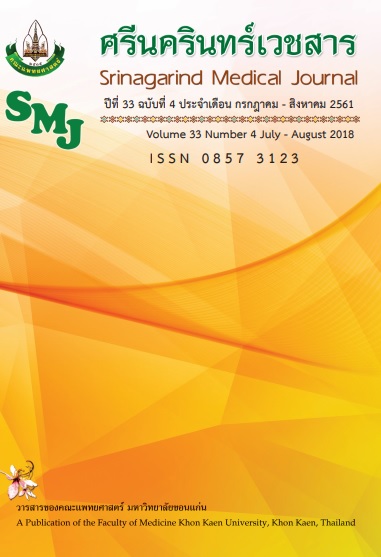Effects of a Self-Management Program for Patients with Chronic Obstructive Pulmonary Disease in Medicine Ward, Khuandon Hospital, Satun Province
Keywords:
Self-Management Program; Chronic Obstructive Pulmonary DiseaseAbstract
Background and Objective: Chronic obstructive pulmonary disease (COPD) is a major public health problem and the rising worldwide increase in morbidity and mortality. This research aimed to investigate the effects of self-management program on knowledge in order to improve self-management for their condition and patient’s with COPD health status.
Methods: This study was performed using quasi-experimental, pretest-posttest design. Samples of twenty patients’ with COPD were invited to participate by purposive sampling technique. The knowledge and health status data were collected by means of a questionnaire. Data were analyzed using descriptive statistics using frequency, percentage and paired t-test is used to compare two population means score.
Results: After the self-management program implementation, a patient has found that the difference between the mean scores of knowledge in order to improve self-management for their condition and patient’s with COPD health status had a significantly higher than those before the program implementation (Mean 3.00, S.D. 0.32 vs Mean 5.65, S.D. 0.67; p < 0.001) and (Mean 20.8,3 S.D. 3.41 vs Mean 19.33, S.D. 3.73; p < 0.001) respectively.
Conclusions: Health personnel can use this program to deploy in the care of patients with chronic obstructive pulmonary disease. Patients to be able to improve their knowledge to use in self-management for their condition and patient’s with COPD health status.
References
2. Wangsom A. Dyspnea management in patients with chronic obstructive pulmonary disease. Thai Journal of Cardio-Thoracic Nursing 2016; 27: 2-12.
3. Setanunt P. Nursing in Acute Attacked Chronic Obstructive Pulmonary Disease (COPD) Patients : A Case study on Kudchum Hospital Yasothon province. Yasothon Medical Journals 2013; 15: 114-22.
4. Donaldson GC, Wedzicha JA. COPD exacerbations .1: Epidemiology. Thorax 2006; 61: 164-8.
5. Lenferink A, Brusse-Keizer M, van der Valk PD, Frith PA, Zwerink M, Monninkhof EM, et al. Self-management interventions including action plans for exacerbations versus usual care in patients with chronic obstructive pulmonary disease. Cochrane Database Syst Rev 2017; 8: Cd011682.
6. Zwerink M, Brusse-Keizer M, van der Valk PD, Zielhuis GA, Monninkhof EM, van der Palen J, et al. Self management for patients with chronic obstructive pulmonary disease. Cochrane Database Syst Rev 2014: Cd002990.
7. Disler RT, Gallagher RD, Davidson PM. Factors influencing self-management in chronic obstructive pulmonary disease: an integrative review. Int J Nurs Stud 2012; 49: 230-42.
8. Bourbeau J, van der Palen J. Promoting effective self-management programmes to improve COPD. Eur Respir J 2009; 33: 461-3.
9. Effing T, Monninkhof EM, van der Valk PD, van der Palen J, van Herwaarden CL, Partidge MR, et al. Self-management education for patients with chronic obstructive pulmonary disease. Cochrane Database Syst Rev 2007: Cd002990.
10. Thangkratok P. The Role of the Nurse in the Chronic Disease Management. Songklanagarind Journal of Nursing 2017; 37: 154-9.
11. Riegel B, Carlson B, Glaser D. Development and testing of a clinical tool measuring self-management of heart failure. Heart Lung 2000; 29: 4-15.
12. Pothirat C, Kiatboonsri S, Chuchottaworn C. Validation of the new COPD assessment test translated into Thai in patients with chronic obstructive pulmonary disease. BMC Pulmonary Medicine 2014; 14: 193.
13. Williams MT, Effing TW, Paquet C, Gibbs CA, Lewthwaite H, Li LSK, et al. Counseling for health behavior change in people with COPD: systematic review. Int J Chron Obstruct Pulmon Dis 2017; 12: 2165-78.
14. Lari SM, Ghobadi H, Attaran D, Mahmoodpour A, Shadkam O, Rostami M. COPD assessment test (CAT): simple tool for evaluating quality of life of chemical warfare patients with chronic obstructive pulmonary disease. Clin Respir J 2014; 8: 116-23.
15. Cabral LF, D'Elia Tda C, Marins Dde S, Zin WA, Guimaraes FS. Pursed lip breathing improves exercise tolerance in COPD: a randomized crossover study. Eur J Phys Rehabil Med 2015; 51: 79-88.
16. Nield MA, Soo Hoo GW, Roper JM, Santiago S. Efficacy of pursed-lips breathing: a breathing pattern retraining strategy for dyspnea reduction. J Cardiopulm Rehabil Prev 2007; 27: 237-44.
17. Spahija J, de Marchie M, Grassino A. Effects of imposed pursed-lips breathing on respiratory mechanics and dyspnea at rest and during exercise in COPD. Chest 2005; 128: 640-50.
18. Khoshkesht S, Zakerimoghadam M, Ghiyasvandian S, Kazemnejad A, Hashemian M. The effect of home-based pulmonary rehabilitation on self-efficacy in chronic obstructive pulmonary disease patients. J Pak Med Assoc 2015; 65: 1041-6.
19. Hsieh MJ, Yang TM, Tsai YH. Nutritional supplementation in patients with chronic obstructive pulmonary disease. J Formos Med Assoc 2016; 115: 595-601.
20. Kaminsky DA, Guntupalli KK, Lippmann J, Burns SM, Brock MA, Skelly J, et al. Effect of Yoga Breathing (Pranayama) on Exercise Tolerance in Patients with Chronic Obstructive Pulmonary Disease: A Randomized, Controlled Trial. J Altern Complement Med 2017; 23: 696-704.




